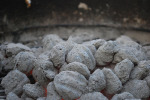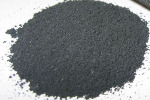Activated Charcoal Filters
Activated charcoal filters reduce odors and remove harmful chemicals. They are used in many air purifiers. They are commonly called activated carbon filters. What do they do?
They help to remove odors and harmful Volatile Organic Compounds (VOCs) from the air.
VOCs are chemicals that can easily change to vapors. Sources of VOCs include paints, glue, and some aerosols. Formaldehyde is a big one that is found inside many buildings. These vapors can hurt you if you breathe enough of them.
How do they work
Activated charcoal filters are made from activated charcoal.
This is not the same charcoal you use in your grill.
Activated charcoal is very porous. Meaning it has a lot of small holes in it. In fact, it is so porous that 1 gram has a surface area larger than 500 square meters.
The charcoal reacts with the chemicals in the air. It changes chemical gases into solids. The solids they can't get back into the air.
Note: Be careful when you remove a charcoal filter. Shaking an activated charcoal filter can cause the gases to be released back into the air.
Size Matters
Dealing with charcoal air filters, size matters. The chemical reactions that take place in the activated charcoal happen on the surface. So . . .
. . . the more surface area the better the air filter works.
The Austin Air Healthmate has 15 pounds of activated charcoal. This is 6,804 grams. The surface area is 36,618,839 square feet.
If you are having trouble visualizing that, think about it this way. That is the same size as 813 football fields.
One pound of activated charcoal only has the same area as 54 football fields.
So which activated charcoal filter do YOU think will do a better job?
Extra Efficiency
Activated charcoal is sometimes combined with other chemicals. Two examples are Zeolite and Potassium. These other chemicals increase the efficiency of the charcoal filter.
How is Activated Charcoal Made?
The process to make activated charcoal begins the same way as regular charcoal.
Usually, charcoal is made from wood or wood by-products (sawdust.) It can be made from anything that contains carbon. We'll use wood in our example.
Wood is heated up to between 1100 and 1600 degrees Fahrenheit. After many hours all that is left of the wood is black charcoal. It is light, soft, and easy to break. It is around 90% carbon.
Now two things can happen.
| The charcoal can be mixed with other ingredients and pressed in briquettes. This is the charcoal you use in your grill. |  |
| The charcoal is processed to create activated charcoal. |  |
To activate charcoal it is exposed to carbon dioxide, oxygen, or steam. It is heated to between 1100 and 2200 degrees Fahrenheit. This produces all the tiny holes in the charcoal.
Activated charcoal can also be created in an entirely chemical process. The wood is soaked in chemicals: an acid, a strong base, or a salt. Then it is heated up. This time the activation happens at the same time. This is the preferred method since it used less heat and takes less time.
Many Uses
Activated charcoal has many uses from industrial uses to medicine. It it used to clean water and air.
Use a charcoal filter in your air purifier. It will remove odors and chemicals from the air.
Many air purifiers include a carbon filter. Check to see if your does. To filter odors and chemicals you need charcoal. The more the better.
Leave Activated Charcoal Filters Page and Return to Air Purifier Filters Page.
Leave Activated Charcoal Filters and Return to All About Air Purifiers Home Page.





New! Comments
We would love to here what you have to say.